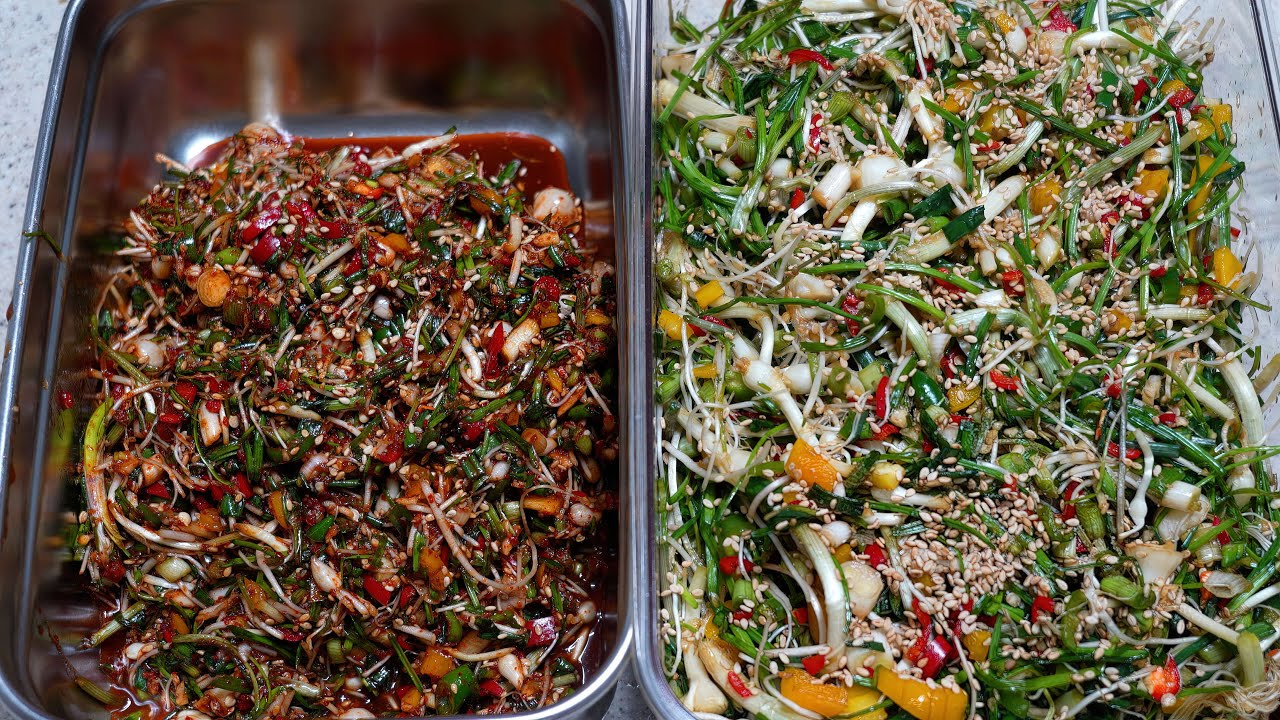Spring Aroma Delight: Easy and Crispy Wild Chive Jangajji Recipe
How to Easily Make Crispy and Fragrant Wild Chive Jangajji with This Spring Recipe

Spring is here, and we’ve made a video for you to enjoy this fragrant wild chive jangajji! Thank you for watching our video and visiting our channel.
Wild Chive Jangajji Vegetable Ingredients- Wild chives 800g
- Scallions 100g
- Cheongyang chili peppers 8
- Red chili peppers 3
- Yellow paprika 1/2
- Minced garlic 2 Tbsp
Wild Chive Jangajji Seasoning Ingredients- Soy sauce 350ml
- Apple syrup 200ml
- Apple cider vinegar 200ml
- Regular soju 100ml
For Making Wild Chive Sauce (Jang) from Jangajji- Wild chive jangajji 200g
- Sesame oil 2 Tbsp
- Gochugaru (red pepper flakes) 2 Tbsp
- Soy sauce 350ml
- Apple syrup 200ml
- Apple cider vinegar 200ml
- Regular soju 100ml
For Making Wild Chive Sauce (Jang) from Jangajji- Wild chive jangajji 200g
- Sesame oil 2 Tbsp
- Gochugaru (red pepper flakes) 2 Tbsp
Cooking Instructions
Step 1
For measurement, a beer cup is 250ml/g, and a paper cup is 200ml/g. ① Vegetable ingredients for wild chive jangajji: 800g wild chives, 100g scallions, 8 Cheongyang chili peppers, 3 large red chili peppers, half a yellow paprika, and 2 Tbsp minced garlic.

Step 2
② Seasoning ingredients for wild chive jangajji: 350ml soy sauce (1 beer cup + half paper cup = 350ml), 200ml apple syrup (1 paper cup), 200ml apple cider vinegar (1 paper cup), 100ml regular soju (half paper cup). Apple syrup can be substituted with corn syrup or other fruit syrups, but using a fruit syrup is recommended. Apple cider vinegar can be substituted with regular vinegar. Adjust to your taste.

Step 3
③ Cutting the washed wild chives. When making jangajji with wild chives, you don’t need to trim them meticulously. Since they are eaten root and all, wash them thoroughly several times until the water runs clear, removing all soil. Cut the wild chives into bite-sized pieces for the jangajji. If the root end of the wild chives is large, cut it in half. Cutting the roots allows the seasoning to penetrate better and makes them easier to eat as a side dish. Although it takes a little extra effort, trimming the roots will result in a tastier jangajji. Wild chives in season are very fragrant, making them delicious in jangajji, but they are also excellent in wild chive sauce (jang) or soybean paste stew (doenjang jjigae).

Step 4
④ Let’s cut the vegetables for the wild chive jangajji. Vegetable ingredients: 100g scallions, 8 Cheongyang chili peppers, 3 large red chili peppers, half a yellow paprika, 2 Tbsp minced garlic. Dicing the yellow paprika adds great texture and color, so I recommend adding it. It’s a vegetable I frequently use when making jangajji. For the spicy red chili peppers, make a cross cut at the top, remove the seeds, and then slice them thinly to resemble a mince. This keeps the brine clean. To remove the seeds, simply make a cross cut and pull them out. Chopping chili peppers might seem difficult, but making a cross cut makes it easy to mince them. Be sure to grip firmly with your left hand to achieve a nice shape. Prepare the Cheongyang chili peppers the same way, making a cross cut at the top. Repeat the process. Mincing Cheongyang chili peppers adds a nice spicy kick to the jangajji brine. Slice the scallions into thin strips and mix with the wild chives. Color coordination makes food look and taste better, so we always include vibrantly colored vegetables. I recommend choosing vegetables based on their color when assembling. Finally, add the minced garlic and mix well. Now, we will add a modest amount of seasoning to make a jangajji that can be eaten immediately.

Step 5
Wild Chive Jangajji Seasoning Ingredients: 350ml soy sauce (1 beer cup (250ml) + half paper cup (100ml) = 350ml), 200ml apple syrup (1 paper cup), 200ml apple cider vinegar (1 paper cup), 100ml regular soju (half paper cup). Apple syrup can be substituted with corn syrup or other syrups, but using a fruit syrup is recommended. Apple cider vinegar can be substituted with regular vinegar. Adjust to your preference. The amount of seasoning in the jangajji is surprisingly small, as per the recipe. First, pour the soy sauce, which balances the flavor – 350ml combined from 1 beer cup (250ml) and half a paper cup (100ml) – directly over the wild chives and vegetables in the container. Next, add the apple cider vinegar, which is diluted and less pungent. Then, add the apple syrup, which provides sweetness and acts as a preservative. Finally, add the soju – half a paper cup (100ml). This ensures the jangajji stays delicious and crisp until you finish it. If you don’t have apple cider vinegar, you can substitute it with regular vinegar, but adjust the amount to your taste. Apple syrup can be replaced with any fruit syrup or corn syrup, but it’s best to use a fruit syrup if possible. If you don’t have regular soju, you can use mirin (14%) or soju like Chum Churum. The mixed wild chive jangajji can be eaten immediately, or by mixing it with gochujang and sesame oil, you can make a delicious wild chive sauce (jang) right away. Wild chive jangajji transformed into jang is perfect for when you have a poor appetite. Store it in the refrigerator. When wild chives are in season and abundant, I highly recommend making jangajji!

Step 6
Add 200g of the wild chive jangajji, 2 Tbsp sesame oil, and 2 Tbsp gochugaru (red pepper flakes) and mix well to serve over rice. It’s truly delicious and wonderful.



